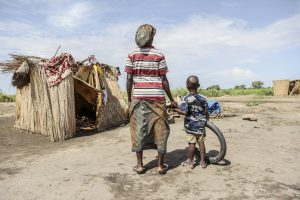What is the Watchlist CAAC Global Dashboard?
The Watchlist Children and Armed Conflict (CAAC) Global Dashboard provides advocates, child protection practitioners, States, researchers, and other stakeholders with a user-friendly tool to examine and analyze data collected and reported by the United Nations (UN) on CAAC.
Since 2002, the UN Secretary-General’s listing mechanism—mandated in 2001 by the UN Security Council—has identified parties to armed conflict deemed responsible for committing grave violations against children during armed conflict. In 2005, the UN Security Council then mandated the Monitoring and Reporting Mechanism on Children and Armed Conflict to document instances of the following grave violations against children during armed conflict:
- Recruitment and use of children by armed forces and armed groups
- Killing and maiming of children
- Rape and other forms of sexual violence against children
- Attacks against schools or hospitals
- Abduction of children
- Denial of humanitarian access for children
The first five of these grave violations can trigger the listing of parties to armed conflict in the annexes to the UN Secretary-General’s annual reports on CAAC. These reports also contain information on the military use of schools and hospitals and the detention of children for their actual or alleged association with parties to armed conflict.
The aim of the Watchlist CAAC Global Dashboard is to collate data on verified, attributable instances of grave violations against children during armed conflict, bringing together and displaying data from the UN Secretary-General’s annual reports on CAAC in a manner intended to be easily digestible and useful for advocacy, analysis, and research within this issue area.
What does the Watchlist CAAC Global Dashboard include?
Country: The Watchlist CAAC Global Dashboard includes conflict situations where parties to armed conflict are listed in the annexes to the UN Secretary-General’s annual reports on CAAC. On the Watchlist CAAC Global Dashboard, users will find data relevant to 27 countries and one regional situation spanning over Africa, the Middle East, Central Asia, Asia-Pacific, Europe, and Latin America. Users should note that the borders and territorial boundaries depicted on the map included in the Watchlist CAAC Global Dashboard are for informational purposes only. They do not reflect Watchlist’s official stance on any disputed territories or the status of statehood. Watchlist makes no claims or assertions regarding the accuracy or legitimacy of the boundaries shown. The UN Secretary-General’s annual reports on CAAC include the Lake Chad Basin region as a regional situation. Watchlist’s Dashboard does not present data disaggregated by party for this regional situation, as the Secretary-General’s annual reports on CAAC do not easily allow for a calculation of grave violations attributable to particular parties within that context.
Names of Parties Responsible: The Watchlist CAAC Global Dashboard identifies parties deemed responsible for grave violations in a manner that matches terminology from the UN Secretary-General’s annual reports on CAAC. For some years, the reports aggregated different parties—for example, various non-state armed groups (NSAGs)—whereas in other years, reports separately specified violations for which these different groups were responsible. Additionally, sometimes NSAGs splinter and change names, meaning that reports in different years refer to the same group in different ways. In all instances, the Watchlist CAAC Global Dashboard identifies parties to armed conflict as they appear in the UN Secretary-General’s annual reports on CAAC.
Reporting Year: The years displayed indicate when the UN reported grave violations, rather than years when grave violations occurred. The UN Secretary-General’s annual reports on CAAC include data on grave violations that occurred in the previous calendar year as well as grave violations that were committed earlier but only verified in the previous calendar year.
Number of Violations: The Watchlist CAAC Global Dashboard displays only verified violations for which the UN Secretary-General’s annual reports on CAAC attribute responsibility to a particular perpetrator. The Watchlist CAAC Global Dashboard includes data relevant to the five aforementioned ‘trigger’ violations, excluding data on denial of humanitarian access for children.
Several points are important to consider about the data:
- The Watchlist CAAC Global Dashboard collates and presents data published in the UN Secretary-General’s annual reports on CAAC. Watchlist did not play a role in collecting or verifying the data included in these reports.
- In most cases, one should assume that the actual number of grave violations is higher than what the Secretary-General’s annual reports on CAAC include, given that unverified grave violations are excluded.
- The numbers of verified grave violations can fluctuate for a variety of reasons—including the extent of the UN’s access in a country or a region, the willingness of victims to report incidents, and insecurity—all of which can impact the ability of the UN to verify and attribute responsibility for grave violations.
- In instances when the Watchlist CAAC Global Dashboard indicates that there were 0 incidents of grave violations, this does not necessarily mean that no grave violations occurred in that situation and/or year, but rather, the United Nations was not able to verify any grave violations. It is important to note that not every violation has been tracked or reported since the inception of the Monitoring and Reporting Mechanism, meaning that a 0 could indicate that the UN was not yet monitoring and reporting on that particular grave violation at that time. In particular, between 2002-2009, the UN Secretary-General’s CAAC reports list parties responsible for grave violations but do not consistently provide data on numbers of grave violations. More consistent reporting of grave violations began with the 2010 report.
- Data from the UN Secretary-General’s annual reports on CAAC sometimes include approximations (“about 500”) or other modifiers (“more than 100”). In all such instances, the Watchlist CAAC Global Dashboard removes such modifiers from the data.
Listing: The Watchlist CAAC Global Dashboard identifies which parties to armed conflict were listed for which grave violation(s) in each year.
What other considerations are important to bear in mind regarding the data in the Watchlist CAAC Global Dashboard?
For more details about the methodology that undergirds the UN Secretary-General’s annual reports on CAAC, which can inform how users should interpret the data included in the CAAC Global Dashboard, see:
- “The Six Grave Violations Against Children During Armed Conflict: The Legal Foundation,” Office of the Special Representative of the Secretary-General for Children and Armed Conflict, October 2009 (updated November 2013).
- “Field Manual: Monitoring and Reporting Mechanism (MRM) on Grave Violations Against Children in Situations of Armed Conflict,” Office of the Special Representative of the Secretary-General for Children and Armed Conflict, United Nations Children’s Fund, and United Nations Department of Peacekeeping Operations, June 2014.
- “Monitoring and Reporting on Grave Violations,” Office of the Special Representative of the Secretary-General for Children and Armed Conflict.
How should I cite the Watchlist CAAC Global Dashboard?
“Watchlist CAAC Global Dashboard,” Watchlist on Children and Armed Conflict, 2024.
Acknowledgements
The Watchlist CAAC Global Dashboard was created by Watchlist on Children and Armed Conflict with funding from the Federal Republic of Germany. However, the views expressed and information contained in it are not necessarily those endorsed by the German government’s official policies. The process of conceiving, designing, and collating data for the Watchlist CAAC Global Dashboard was led by Aleksandra Jelonek.
For questions, suggestions, or media inquiries, please contact us at watchlist@watchlist.org.






